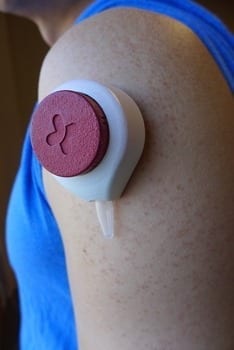
Photo: David Tenenbaum
A company with deep roots at UW-Madison wants to make blood sampling less painful and more convenient. Tasso Inc. is perfecting a device the size of a pingpong ball that extracts a small sample while held against the skin for two minutes.
During this time, a slight vacuum in the device enables a small sample of blood to flow into an attached sample tube, which can be mailed or handed to a lab. Users report that the process is almost entirely painless.
The company has just received an additional $3 million from the Defense Advanced Research Projects Agency (DARPA) to advance its product.
The technology relies on the forces that govern the flow of tiny fluid streams, says Ben Casavant, vice president and co-founder. “At these scales, surface tension dominates over gravity, and that keeps the blood in the channel no matter how you hold the device.”
The company — whose name means “badger” in Italian — has applied for a patent on channels that create capillary action to move blood toward the sample tube.
All three of the founders studied this technology, called microfluidics, in the lab of David Beebe, professor of biomedical engineering at UW-Madison. “I was studying circulating tumor cells,” says Casavant. “Erwin (Berthier, now head of research and development) was looking at the movement of immune cells, and Ben (Moga, now president) was working on an injectable-device startup.”
The patent pending invention was made during a different project in Beebe’s lab, Casavant says, and it sparked a classic startup story. “In 2010, Erwin and I were in a coffee shop, and we thought, ‘Let’s start a company — but about what?’ We wanted to use all the cool stuff we had learned to help people, to make products that are useful.”
Moving the blood in open channels rather than traditional closed channels will simplify manufacturing and cut costs for a disposable device that needs as few as six injection-molded plastic parts, says Casavant.
The DARPA grant will fund work with companies that make blood preservatives. The agency’s goal is to stabilize the blood so it can survive one week at 140 degrees Fahrenheit and still be fit for analysis. That would enable the invention to be used to sample in a wide range of locations without needing costly cold-chain transportation.
With funding from the National Institutes of Health, Tasso is also developing a technique for taking samples to diagnose HIV. Currently, the device can extract about 0.15 of a cubic centimeter, enough to test cholesterol, infection, cancer cells and blood sugar — “basically anything that is being tested for in a modern lab,” Casavant says.
Read more: Simple sample: Federal grant advances pain-free blood tests from UW startup
The Latest on: Blood sampling
[google_news title=”” keyword=”Blood sampling” num_posts=”10″ blurb_length=”0″ show_thumb=”left”]
via Google News
The Latest on: Blood sampling
- Knoxville residents can try a new blood test to screen for cancer before a colonoscopyon April 26, 2024 at 2:24 pm
ColoHealth is the next generation of the first and only FDA-approved blood test for colorectal cancer screening, Epi proColon, and it looks for altered DNA associated with the cancer. New ...
- Monday at 5:30: DUI blood sample backlog causing danger on our roadson April 26, 2024 at 12:46 pm
Monday at 5:30, Linzi Sheldon investigates the growing trend that’s causing danger on your commute and shares the story of one Federal Way man who is battling to recover from burns as he waits for ...
- Blood test may be able to detect osteoarthritis 8 years earlier than X-rayon April 26, 2024 at 12:00 pm
A blood test could help predict knee osteoarthritis at least eight years before the signs of the disease show up on X-rays, a new study indicates.
- DPNR to Provide Free Ice for Commercial Port Sampling Programon April 26, 2024 at 3:07 am
The Division of Fish and Wildlife reminds all commercial fishers, as a stipulation of their commercial fishing license, that they must complete one port sample per quarter.
- Vietnam Patient Blood Management Market Beyond the Forecast Market Size’s Skyrocketing Future Outlookon April 24, 2024 at 3:23 pm
Request To Download Free Sample of This Strategic Report @ This country research report on Vietnam Market offers comprehensive insights into the market landscape, customer intelligence, and ...
- CTDOT, Hartford HealthCare train police on how to draw bloodon April 24, 2024 at 9:40 am
Police officers in Connecticut stopping suspected drunk drivers may soon have another way of telling if you’ve had too much to drink.
- Prosecutors: blood in home of Maxwell Anderson not victimson April 22, 2024 at 8:11 pm
Maxwell Anderson appeared in court accused of killing and dismembering Sade Robinson on their first date. In what amounted to incredibly damning testimony, former National Enquirer publisher David ...
- TikTok resellers have turned NYC designer sample sales into blood sporton April 22, 2024 at 3:33 pm
More and more resellers — who hawk their scores on TikTok and resale sites such as Whatnot and Poshmark — are hitting up the sales with a cutthroat approach. They pay people to wait in line for them, ...
- Infected blood victim mum 'treated like a sample'on April 21, 2024 at 11:50 pm
A woman said her mother was "treated like a sample, rather than a person" after she contracted hepatitis C during the infected blood scandal. Debbie Kemp's mum, Susan Wakeling, from Bramford near ...
- Babson Diagnostics develops hand-warming device for blood sample collectionon April 17, 2024 at 4:29 am
The device helps to effectively warm the hand, a technique known to facilitate blood collection from a fingertip.
via Bing News









